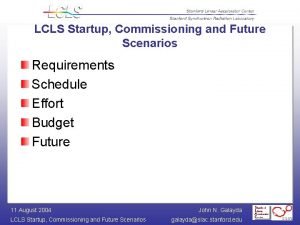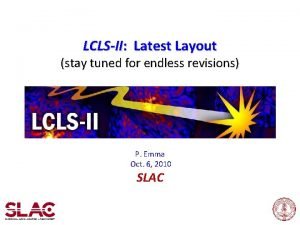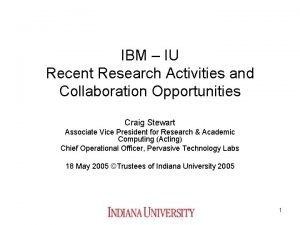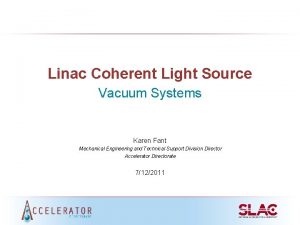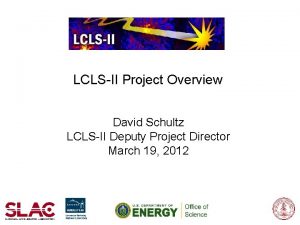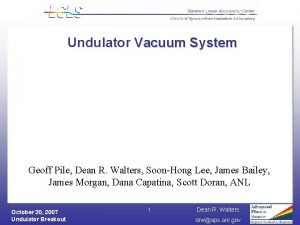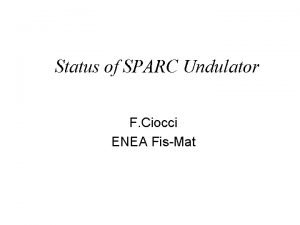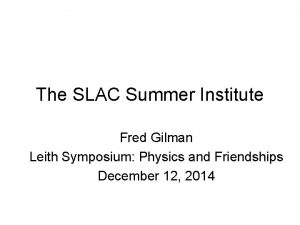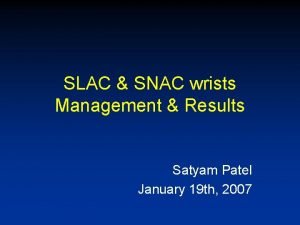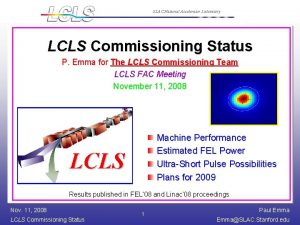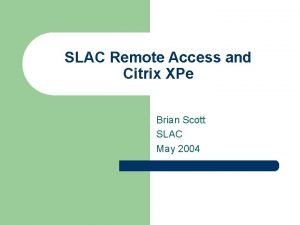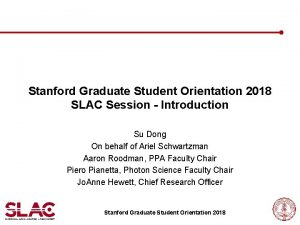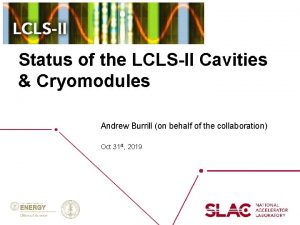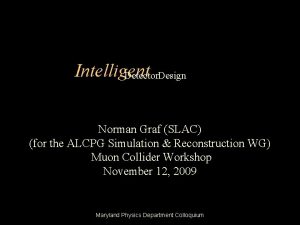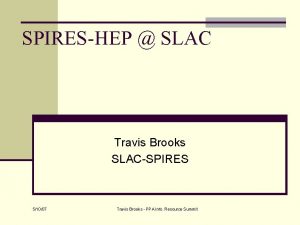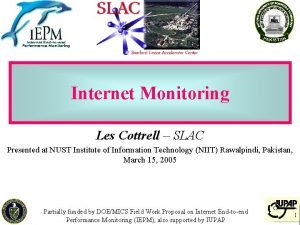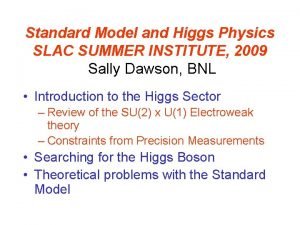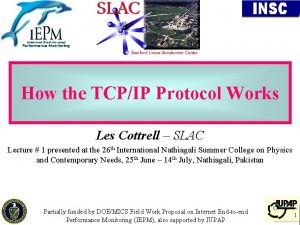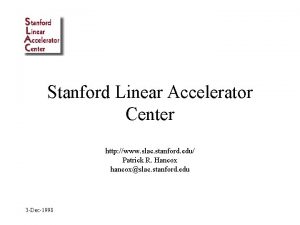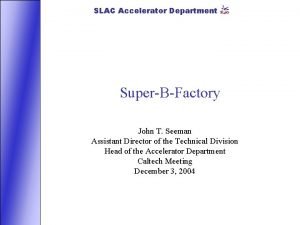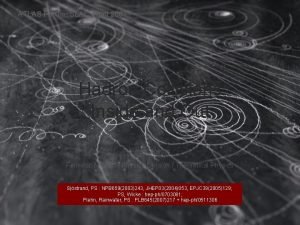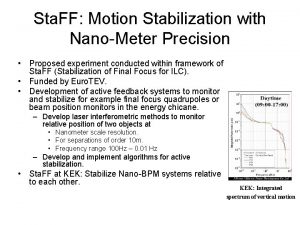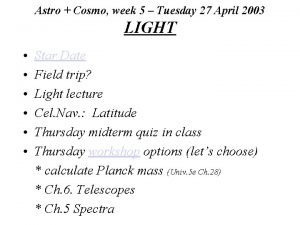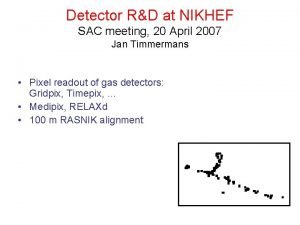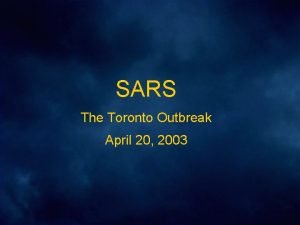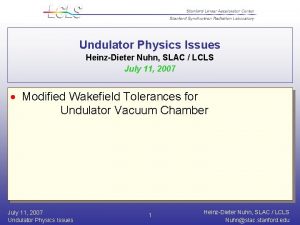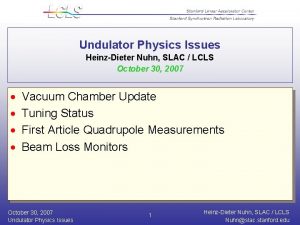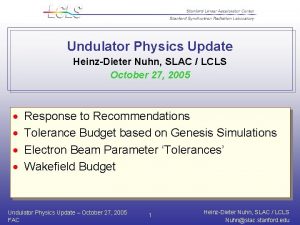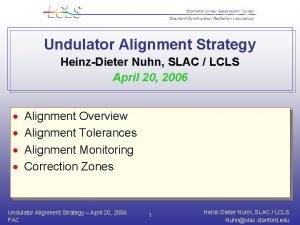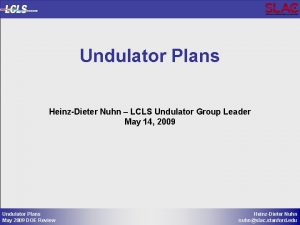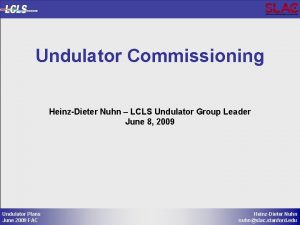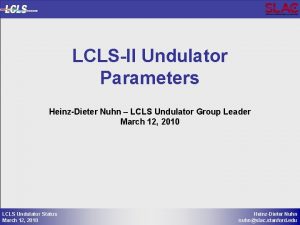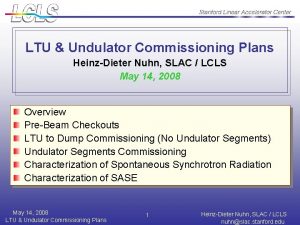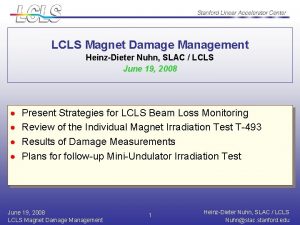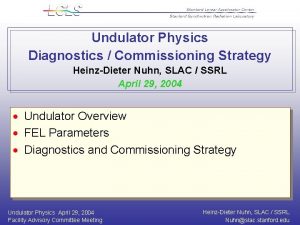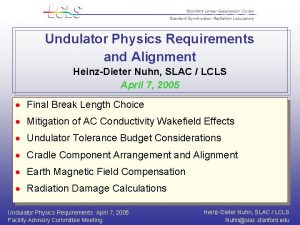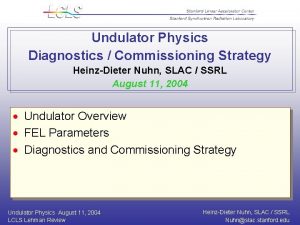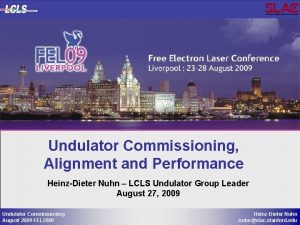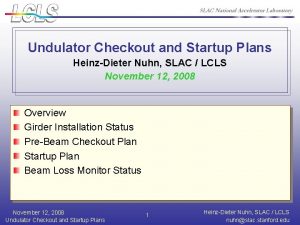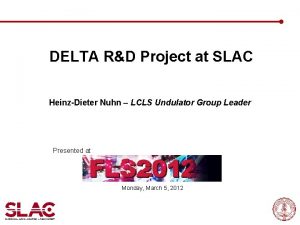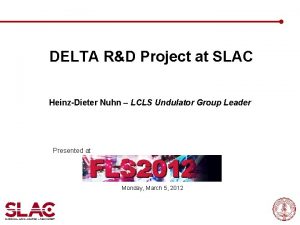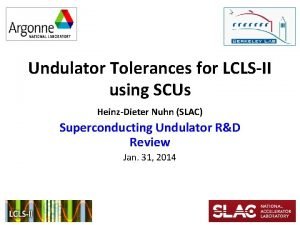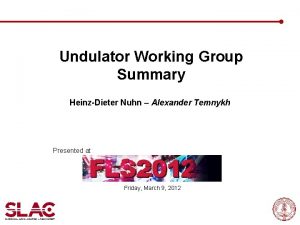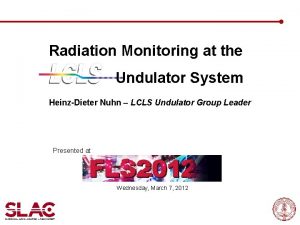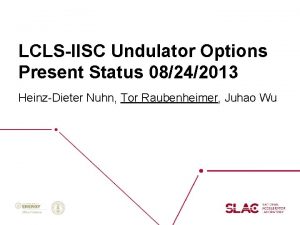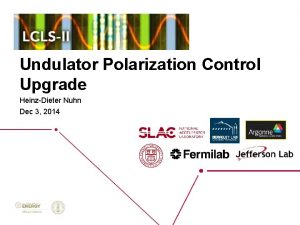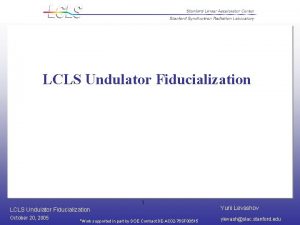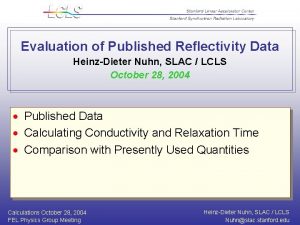Undulator Physics Issues HeinzDieter Nuhn SLAC LCLS April




![Present Tuning Status 1. Serial Number: L 143 -112000 -02 [Slot: 01] Rough Tuning: Present Tuning Status 1. Serial Number: L 143 -112000 -02 [Slot: 01] Rough Tuning:](https://slidetodoc.com/presentation_image_h2/72ea5be37e7712c292fad9480de5cbba/image-5.jpg)




























- Slides: 33

Undulator Physics Issues Heinz-Dieter Nuhn, SLAC / LCLS April 16, 2007 Vacuum Chamber Update Tuning Results Undulator Pole Tip Locations Beam Loss Monitors April 16, 2007 Undulator Physics Issues 1 Heinz-Dieter Nuhn, SLAC / LCLS Nuhn@slac. stanford. edu

Vacuum Chamber Update The vacuum chamber is making progress. The two competing designs (ANL vs SLAC) have been reviewed on February 22. LCLS management has chosen the ANL design. A ‘ready-to-install’ prototype had been completed by the review. Vacuum tests were completed with good result. The chamber has been cut to produce samples for permeability and roughness measurements of the coated surface. Theses measurements have not yet been completed. April 16, 2007 Undulator Physics Issues 2 Heinz-Dieter Nuhn, SLAC / LCLS Nuhn@slac. stanford. edu

Tuning Results The procedures for tuning and measuring the LCLS undulator magnets are described in LCLS-TN-06 -17 “LCLS Undulator Test Plan” The document identifies three distinct phases: • Rough Tuning • Fine Tuning • Tuning Results (Final Measurements) During Rough Tuning, a target position (Slot number) is assigned to the undulator based on its strength and the gap height is adjusted according to the Slot number. During Fine Tuning, the tuning axis is determined and the magnetic fields are corrected along that axis. In addition, the field integrals in the roll-out location are measured and corrected, as necessary. The Final Measurement phase begins after the tuning process is completed. Its purpose is to document the tuning results and to provide data necessary for understanding the behavior of the undulator during commissioning and operation. April 16, 2007 Undulator Physics Issues 3 Heinz-Dieter Nuhn, SLAC / LCLS Nuhn@slac. stanford. edu

Tuning Requirements 1. At Tuning Axis Parameter Target Value Tolerance Comment Keff See Table 0. 015 % Effective Undulator parameter I 1 x 0 µTm 40 µTm First Horizontal Field Integral I 2 x 0 µTm 2 50 µTm 2 Second Horizontal Field Integral I 1 y 0 µTm 40 µTm First Vertical Field Integral I 2 y 0 µTm 2 50 µTm 2 Second Vertical Field Integral 113 × 360º 10º Total Undulator Segment phase slippage Avg core phase shake*) 0º 10º Average phase deviation along z for core periods RMS core phase shake*) 0º 10º RMS phase deviation along z for core periods Total Phase (over 3. 656 m)*) *) For radiation wavelength of 1. 5 Å 2. At Roll-Out Position Parameter Target Value Tolerance Comment I 1 x ~100 µTm 40 µTm First Horizontal Field Integral I 2 x ~200 µTm 2 50 µTm 2 Second Horizontal Field Integral I 1 y ~100 µTm 40 µTm First Vertical Field Integral I 2 y ~120 µTm 50 µTm 2 Second Vertical Field Integral April 16, 2007 Undulator Physics Issues 4 Heinz-Dieter Nuhn, SLAC / LCLS Nuhn@slac. stanford. edu
![Present Tuning Status 1 Serial Number L 143 112000 02 Slot 01 Rough Tuning Present Tuning Status 1. Serial Number: L 143 -112000 -02 [Slot: 01] Rough Tuning:](https://slidetodoc.com/presentation_image_h2/72ea5be37e7712c292fad9480de5cbba/image-5.jpg)
Present Tuning Status 1. Serial Number: L 143 -112000 -02 [Slot: 01] Rough Tuning: Complete Fine Tuning: Complete 2. Serial Number: L 143 -112000 -03 [Slot: 25] Rough Tuning: Complete Fine Tuning: Complete 3. Serial Number: L 143 -112000 -17 [Slot: 02] Rough Tuning: Complete Fine Tuning: Complete 4. Serial Number: L 143 -112000 -06 [Slot: ] [Larger than expected matching errors] Rough Tuning: Complete Fine Tuning: In Progress 5. Serial Number: L 143 -112000 -11 [Slot: 04] Rough Tuning: Complete Fine Tuning: - 6. Serial Number: L 143 -112000 -13 [Slot: ] Rough Tuning: In Progress Fine Tuning: - April 16, 2007 Undulator Physics Issues 5 Heinz-Dieter Nuhn, SLAC / LCLS Nuhn@slac. stanford. edu

Measured Keff vs x for SN 02 Target Keff = 3. 5 Fit: Keff=K 0+K 1 x+K 2 x 2+K 3 x 3 K 0 = 3. 500077 K 1 = 0. 002754 K 2 = -0. 000017 K 3 = -0. 000002 (1/B 0) d. B/dx = 0. 0787 %/mm Estimated cant angle: 5. 4 mrad April 16, 2007 Undulator Physics Issues 6 Heinz-Dieter Nuhn, SLAC / LCLS Nuhn@slac. stanford. edu

Measured Phase Shake through LCLS Undulator SN 02 E: 13. 64 Ge. V <Df> = 0. 00º (Df-<Df>)rms = 3. 66º Wiggler Period Averaged Spec Range RMS Deviation Undulator Average April 16, 2007 Undulator Physics Issues 7 Heinz-Dieter Nuhn, SLAC / LCLS Nuhn@slac. stanford. edu

First Bx Field Integral Measurements April 16, 2007 Undulator Physics Issues 8 Heinz-Dieter Nuhn, SLAC / LCLS Nuhn@slac. stanford. edu

Change of Bx Shim Design Original shim design used in SN 02 and SN 03. New shim design used in SN 17 and SN 06 so far. April 16, 2007 Undulator Physics Issues 9 Heinz-Dieter Nuhn, SLAC / LCLS Nuhn@slac. stanford. edu

Second Bx Field Integral Measurements April 16, 2007 Undulator Physics Issues 10 Heinz-Dieter Nuhn, SLAC / LCLS Nuhn@slac. stanford. edu

First By Field Integral Measurements April 16, 2007 Undulator Physics Issues 11 Heinz-Dieter Nuhn, SLAC / LCLS Nuhn@slac. stanford. edu

Second By Field Integral Measurements April 16, 2007 Undulator Physics Issues 12 Heinz-Dieter Nuhn, SLAC / LCLS Nuhn@slac. stanford. edu

Measured Roll-Out Trajectory for LCLS Undulator SN 02 E: 13. 64 Ge. V Upper: Horizontal <x> = 4. 01 µm (x)rms= 3. 26 µm I 1 y: 71. 7 µTm I 2 y: 433. 6 µTm 2 Lower: Vertical <y> = -1. 27 µm (y)rms= 1. 42 µm I 1 x: -128. 9 µTm I 2 x -220. 4 µTm 2 April 16, 2007 Undulator Physics Issues Undulator Average 13 RMS Deviation Heinz-Dieter Nuhn, SLAC / LCLS Nuhn@slac. stanford. edu

Earth Field Corrected Roll-Out Trajectory for LCLS Undulator SN 02 E: 13. 64 Ge. V Upper: Horizontal <Dx> = 2. 89 µm (Dx)rms= 2. 28 µm DI 1 y: 0. 0 µTm DI 2 y: 281. 3 µTm 2 Lower: Vertical <Dy> = 0. 75 µm (Dy)rms= 0. 48 µm DI 1 x: 0. 0 µTm DI 2 x 53. 4 µTm 2 April 16, 2007 Undulator Physics Issues Undulator Average RMS Deviation 14 Heinz-Dieter Nuhn, SLAC / LCLS Nuhn@slac. stanford. edu

Undulator Pole Tip Locations The geometrical position of the pole faces is being measured in the MMF on the CMM as the magnets arrive at SLAC. Unexpectedly large distributions of per-pole as well as undulator-averaged values were found for the following mechanical dimensions: Cant Angles Gap Heights Vertical Mid-Plane Positions April 16, 2007 Undulator Physics Issues 15 Heinz-Dieter Nuhn, SLAC / LCLS Nuhn@slac. stanford. edu

Cant Angles Distributions for SN 03 April 16, 2007 Undulator Physics Issues 16 Heinz-Dieter Nuhn, SLAC / LCLS Nuhn@slac. stanford. edu

Cant Angle Measurements RMS Spread over 226 poles April 16, 2007 Undulator Physics Issues 17 Heinz-Dieter Nuhn, SLAC / LCLS Nuhn@slac. stanford. edu

Pole Tip Locations for SN 03 Quasi-periodic gap-height variations 85 µm Overall mid-plane sag 106 µm April 16, 2007 Undulator Physics Issues 18 Heinz-Dieter Nuhn, SLAC / LCLS Nuhn@slac. stanford. edu

Undulator Pole Tip Locations Summaries Very close to the 6. 8 mm minimum required to insert the vacuum chamber. April 16, 2007 Undulator Physics Issues 19 Heinz-Dieter Nuhn, SLAC / LCLS Nuhn@slac. stanford. edu

Undulator Pole Tip Locations Summary Most of the effects of the unexpectedly large distributions of per-pole as well as undulatoraveraged values for cant angles, gap heights, and mid-plane-positions can be compensated in the tuning process. Presently, only the larger than expected cant angles will have remnant effect. They require a reduction of the horizontal alignment tolerance from 140 microns. April 16, 2007 Undulator Physics Issues 20 Heinz-Dieter Nuhn, SLAC / LCLS Nuhn@slac. stanford. edu

Beam Loss Monitors (BLMs) Radiation protection of the permanent magnet blocks is very important. Funds are limited and efforts need to be focused to minimize costs. A Physics Requirement Document is being written to define the minimum requirements. April 16, 2007 Undulator Physics Issues 21 Heinz-Dieter Nuhn, SLAC / LCLS Nuhn@slac. stanford. edu

Estimated Radiation-Based Magnet Damage The loss of magnetization caused by a given amount of radiation has been estimated by Alderman et al. [[i]]. Their results imply that a 0. 01% loss in magnetization occurs after absorption of a total fast-neutron fluence of 1011 neutrons/cm 2. Recent measurements by Sasaki et al. at the APS (published in PAC 05) question those findings of the importance of the neutron flux. [i] J. Alderman, et. A. , Radiation Induced Demagnetization of Nd-Fe-B Permanent Magnets, Advanced Photon Source Report LS-290 (2001) April 16, 2007 Undulator Physics Issues 22 Heinz-Dieter Nuhn, SLAC / LCLS Nuhn@slac. stanford. edu

Estimate of Neutron Fluences The radiation deposited in the permanent magnets blocks of the LCLS undulator, when a single electron (e-) strikes a 100 -µm carbon foil upstream of the first undulator, has been simulated by A. Fasso [[i]]. The results are a peak total dose of about 1. 0× 10 -9 rad/eincluding a neutron (n) fluence of 1. 8× 10 -4 n/cm 2/e-. This translates into 1. 8× 105 n/cm 2 for each rad of absorbed energy. These numbers are based on peak damage situations and should therefore be considered as worst case estimates. [i] A. Fasso, Dose Absorbed in LCLS Undulator Magnets, I. Effect of a 100 µm Diamond Profile Monitor, RP-05 -05, May 2005. April 16, 2007 Undulator Physics Issues 23 Heinz-Dieter Nuhn, SLAC / LCLS Nuhn@slac. stanford. edu

Simulated Neutron Fluences Simulated neutron fluences in the LCLS undulator magnets (upper Yaw) from a single electron hitting a 100 micron thick carbon foil upstream of the first undulator. Maximum Level is 1. 8× 10 -4 n/cm 2/e- April 16, 2007 Undulator Physics Issues 24 Heinz-Dieter Nuhn, SLAC / LCLS A. Fasso Nuhn@slac. stanford. edu

Total Dose from e- hitting a Carbon Foil Corresponding maximum deposited dose. Maximum Level is 1. 0× 10 -9 rad/e- April 16, 2007 Undulator Physics Issues 25 Heinz-Dieter Nuhn, SLAC / LCLS A. Fasso Nuhn@slac. stanford. edu

Radiation Limit Estimates Neutron fluence for 0. 01 % magnet damage from Alderman et al. 1× 1011 n/cm 2 Maximum neutron fluence in LCLS magnets from hit on 100 micron C foil from Fasso 1. 8× 10 -4 n/cm 2/e- Maximum total dose in LCLS magnets from hit on 100 micron carbon foil from Fasso 1× 10 -9 rad/e- Ratio of neutron fluence per total dose 1. 8× 105 n/cm 2/rad Maximum total dose in LCLS magnets for 0. 01 % damage 5. 5× 105 rad Nominal LCLS lifetime 20 years Number of seconds in 20 years 6. 3× 108 s Maximum average permissible energy deposit per magnet 8. 8× 10 -4 rad/s Corresponding per pulse dose limit during 120 Hz operation 7. 3 µrad/pulse April 16, 2007 Undulator Physics Issues 26 Heinz-Dieter Nuhn, SLAC / LCLS Nuhn@slac. stanford. edu

Maximum Estimated Radiation Dose from BFW Operation Maximum neutron fluence in LCLS magnets due to BFW hit; All undulators rolled-in; from Welch based on Fasso. Total Charge: 1 n. C; Wire Material: C; Wire Diameter 40 µm; RMS Beam radius 37 µm; 1. 5× 105 n/cm 2/pulse Radiation dose corresponding to BFW hit 0. 85 rad/pulse Ratio of peak required dose to maximum average dose 1. 8× 105 Ratio for 0. 1 n. C charge 1. 8× 104 Ratio for 0. 1 n. C charge and down-stream undulators rolled-out (assuming factor 100 reduction) 1. 8× 102 April 16, 2007 Undulator Physics Issues 27 Heinz-Dieter Nuhn, SLAC / LCLS Nuhn@slac. stanford. edu

Radiation Sources BFW operation Is expected to produce the highest levels. May only be allowable when all down-stream undulators are rolled-out and beam charge is reduced to minimum. Foil insertion May only be allowable when all undulators are rolled-out and beam charge is reduced to minimum. Background radiation Currently not known. Radiation levels potentially higher than maximum desirable per-pulse dose. BLMs could get saturated from non-demagnetizing radiation component Beam Halo Expected to be sufficiently suppressed through collimator system. May require halo detection system. Beam Missteering Will be caught by BCS and will lead to beam abort. April 16, 2007 Undulator Physics Issues 28 Heinz-Dieter Nuhn, SLAC / LCLS Nuhn@slac. stanford. edu

Detector Considerations One BLM device will be mounted upstream of each Undulator Segment with 2 p sensitivity around beam pipe. The BLM will provide a signal proportional to the amount of energy deposited in the device for each electron bunch. The BLM shall be able to detect and precisely (1%) measure radiation levels corresponding to magnet dose levels as low as 0. 01 mrad/pulse and up to the maximum expected level of 10 mrad/pulse. The BLM needs to be designed to withstand the highest expected radiation levels without damage. The radiation level received from each individual electron bunch needs to be reported within 1 msec after the passage of that bunch. The following additional detectors are under consideration: Halo detector after last undulator. Integrating fiber installation in first segments for investigational purposes. Dosimeters mounted on the front faces of the Undulator Strongbacks. April 16, 2007 Undulator Physics Issues 29 Heinz-Dieter Nuhn, SLAC / LCLS Nuhn@slac. stanford. edu

Detector Calibration Beam Loss Monitor Calibration will be based on well defined calibration events. A single pulse of known charge hitting a BFW wire or an upstream foil. The events will be simulated by Radiation Physics. The simulations will yield Neutron fluence levels in the magnets Dose levels in the detectors The measured detector voltages will be calibrated with the simulated radiation levels. April 16, 2007 Undulator Physics Issues 30 Heinz-Dieter Nuhn, SLAC / LCLS Nuhn@slac. stanford. edu

Machine Protection System Requirements The Beam Protection system (MPS) will use the signal from the BLM immediately preceding an Undulator Segment together with the rollin/out status of that Undulator Segment after the expected passage of each electron bunch to calculate the incremental dose received by the magnets of that Undulator Segment. The MPS for the Undulator System will run in one of three beam modes: (1) Single Shot, (2) Recovery (3) Standard. The estimated magnet dose will be used to control running parameters. April 16, 2007 Undulator Physics Issues 31 Heinz-Dieter Nuhn, SLAC / LCLS Nuhn@slac. stanford. edu

Summary Significant progress in the vacuum chamber development occurred since the last FAC. Still waiting for the final surface roughness and permeability measurements. Mechanical dimensions of the undulators show fairly large spread. Tuning can compensate for most of it. Larger than expected can angles require reduction in horizontal alignment tolerance. Tuning of the first three undulators complete. Results are very encouraging. A modification in the Bx shim design appears to reduce the harmonics in the field integrals. The Beam Loss Monitor requirements are reexamined to derive minimum requirements in order to reduce costs. April 16, 2007 Undulator Physics Issues 32 Heinz-Dieter Nuhn, SLAC / LCLS Nuhn@slac. stanford. edu

End of Presentation April 16, 2007 Undulator Physics Issues 33 Heinz-Dieter Nuhn, SLAC / LCLS Nuhn@slac. stanford. edu
 Lcls schedule
Lcls schedule Lcls
Lcls Lcls
Lcls Undulator
Undulator Undulator
Undulator Undulator
Undulator Undulator
Undulator Slac summer school
Slac summer school Slac snac wrist
Slac snac wrist Statusp
Statusp Mei bai slac
Mei bai slac Stanford citrix
Stanford citrix Slac student loan
Slac student loan Andrew burrill slac
Andrew burrill slac Confluence slac
Confluence slac Slac spires
Slac spires Network data collection at slac
Network data collection at slac Slac summer institute
Slac summer institute Ip fragmentation
Ip fragmentation Stanford remote desktop
Stanford remote desktop Slac
Slac Slac
Slac Slac sta
Slac sta Slac vpn
Slac vpn University physics with modern physics fifteenth edition
University physics with modern physics fifteenth edition Simple physics ia ideas
Simple physics ia ideas Why does it happen
Why does it happen Kenn nesbitt
Kenn nesbitt Wetter paris märz
Wetter paris märz 27 april 2003
27 april 2003 20 april
20 april 2003 april 20
2003 april 20 April mythology
April mythology April kindergarten newsletter
April kindergarten newsletter
